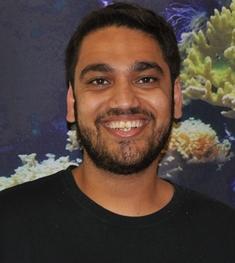Australians love their seafood, which makes protecting the safety and sustainability of this resource is a high priority. But a growing problem for seafood producers and public health authorities is an increase in incidents of shellfish poisoning.
The source of the danger is harmful algal blooms delivering a powerful cocktail of biotoxins that are hard to detect when they accumulate in shellfish. These biotoxins are also immune to temperature variation, so won’t be destroyed by cooking.
Over a 45-year period, there have been an estimated 13,500 cases – and two deaths – from ciguatera, a type of seafood biotoxin that’s the most seriously rated seafood risk in Australia.
But game-changing research in the UTS Seafood Safety Program has led to the development of an early warning system that’s being enthusiastically taken up by the multimillion-dollar seafood industry and safety regulators.
Led by Associate Professor Shauna Murray, a team at UTS has built a diagnostic tool that can predict one type of harmful algal bloom up to two weeks before it eventuates. They have also set up a separate facility to test fish that may be contaminated.
Rejoicing in the name the DinoDTec Toxin Gene Test, this world-first molecular-based diagnostic kit underwent nearly two years of trials with Australia’s biggest mussel farm, Tasmania’s Spring Bay Seafoods. After successfully identifying emerging algal bloom events, enabling farmers to move production to toxin-free sites, the kit was commercialised by Australian biotechnology company Diagnostic Technology and is now being used by aquaculture farms and shellfish safety regulators.
Seeing the research go from concept to practical application has been very rewarding, Dr Murray says.
“The whole arc of the process – starting with a fairly ‘blue sky’ research idea in algal genetics and toxins, finally getting results after a lot of trial and error, seeing it patented, developing it for commercialisation, developing pipelines so it can be used in a farm, using these methods on a larger scale and seeing them working – it’s taken quite a few years, but it’s certainly satisfying.”
Satisfying and cost-effective. If NSW were to move to the DinoDTec kit rather than use existing methods, the saving for businesses is estimated at $140,000 a year.
Toxin detection has also led to critical reforms in the way some fish are procured at the Sydney Fish Market. And a collaboration with Hornsby Council in Sydney has resulted in Algalert, an online information hub that provides advice on how to respond to harmful algal blooms. Used by councils and water management authorities, Algalert won the NSW Annual Coastal Management Innovation award in 2016.
Dr Murray’s success in bringing together so many organisations was critical to the commercialisation of the product, says Diagnostic Technology’s Managing Director, Mark Van Asten.
“Dr Murray brings together a broader collaborative group into partnership with us which normally would be difficult to organise but is extremely useful to the development of our scientific knowledge,” Van Asten says. “From French research institutes to the NSW Food Authority, she assists in establishing credible scientific contacts that allow us to move the collaboration process forward.”
Working closely with these groups means what we develop is ready to go.
— Dr Shauna Murray
Dr Murray says the drive has always been to see the new techniques the UTS team develops being put into use.
“For that [to happen] we need to make sure we work closely with regulators and the seafood industry. We need to work closely with the biotech industry for the commercialisation of the work. Also working closely with these groups means what we develop is ready to go – it's been designed already to suit the needs of the industry.”
The biotoxin prediction kit has attracted international attention and is being used by scientists in the UK and China, with further international trials at locations susceptible to harmful algal blooms in the US and France. There are also plans to apply the research in developing countries.
“We are using similar techniques to look into other seafood safety issues,” Dr Murray says. “These are particularly problematic in small island countries, for example in the Pacific, where seafood is a major part of the diet and is being impacted by climate change.”
It seems the UTS breakthrough research couldn't be more timely.
Facts and figures
- Ciguatera Fish Poisoning (CFP) occurs through the consumption of fish that have accumulated naturally occurring toxins.
- CFP is the most common non-bacterial illness associated with fish consumption internationally, affecting up to 500,000 people a year
- In Australia, cases have occurred after the consumption of fish caught in Queensland, the Northern Territory and NSW.
- Spanish Mackerel is the principal fish species to have resulted in cases in NSW and Queensland.
- Ciguatoxins are odourless and tasteless, therefore it is difficult to distinguish toxic fish from those that are harmless.
- CFP occurrence worldwide is increasing, with reports of a 60% rise in the Pacific region over the past decade.
Source: Safeguarding seafood consumers in NSW from ciguatera fish poisoning (PDF, 746KB)
Download
Murray, SA, Kohli, GS, Harwood, DT, Laczka, O & Boulter, M Fisheries Research and Development Corporation 2016, Safeguarding seafood consumers in NSW from ciguatera fish poisoning (PDF, 746KB), no. ISBN 978-0-646-95465-3, pp. 1-51, Canberra, ACT, Australia.
Research team
-
Associate Professor, School of Life Sciences
-
Research Fellow, School of Life Sciences
-
 Arjun VermaPostdoctoral Research Associate, School of Life Sciences
Arjun VermaPostdoctoral Research Associate, School of Life Sciences
Faculty and unit
- Faculty of Science
- Climate Change Cluster
Funded by
- Australian Research Council
- Fisheries Research and Development Corporation
- Food Agility CRC
- Hornsby Council
- Northern Beaches Council





